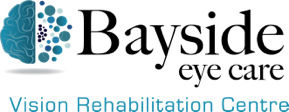When it comes to vision problems, myopia and hyperopia are relatively common conditions. But not everyone knows how these 2 vision conditions are different or what the symptoms and treatment options are for myopia and hyperopia.
Both myopia and hyperopia can cause blurry vision at different distances—myopia can make it more difficult to see things further away, while hyperopia can make closer objects appear blurry or fuzzy. Typically, both of these optical conditions can be treated through the use of corrective eyeglasses or contact lenses.
A comprehensive eye exam and information from your optometrist can help you determine which condition is affecting your vision—and which form of vision support can meet your needs for clear vision.
What Is Myopia?
Myopia, also known as nearsightedness, is a common vision condition that affects nearly 30% of Canadians. It can develop when the shape of your eye grows longer than it is wide and causes light to focus in front of your retina rather than on it, making objects appear blurrier the further away they are.
This condition often develops during childhood or adolescence and tends to progress until adulthood. However, in some rare cases, it can develop in adulthood due to environmental factors like excessive reading, computer use, or lack of exposure to sunlight.
What Are the Symptoms of Myopia?
Nearsightedness can impact all aspects of your daily life due to its nature. Having the ability to see distant objects is invaluable, but this condition can make seeing things far away quite challenging.
Myopia’s common symptoms include:
- Blurry vision
- Difficulty focusing
- Eye strain
- Headaches
- Frequent squinting
Because myopia typically develops during early childhood or adolescence, it can lead to challenges in school as a result of difficulty seeing chalkboards, reading textbooks, or even seeing a television.
Much of a child’s learning is vision-based, making it essential to regularly schedule children’s eye exams to monitor their eye health and help provide them with the vision support they may need to succeed in school.
What Is Hyperopia?
Hyperopia, also known as farsightedness, is a vision condition that can cause nearby objects to appear blurry while distant objects remain clear—almost acting as the exact opposite of myopia. Hyperopia can develop when the shape of your eye causes light rays to converge at a point behind the retina rather than directly on it.
Hyperopia can be caused by genetic or environmental factors but may also develop as a natural part of the aging process. People with hyperopia may experience eye strain when performing tasks close to their face, like reading, writing, or watching a screen.
What Are the Symptoms of Hyperopia?
Since hyperopia can make it difficult to see objects closer to your face rather than further away, it can lead to difficulty performing many daily tasks without some form of vision support.
The symptoms of farsightedness can include:
- Blurry vision
- Difficulty reading
- Trouble writing
- Difficulty drawing
- Eye fatigue after working on close-up tasks
- Headaches
- Eye strain
Hyperopia can lead to many challenges in your day-to-day life, but we can help you detect and manage it when you visit us for a comprehensive eye exam.
What Are the Vision Correction Options for Myopia & Hyperopia?
Fortunately, when it comes to correcting myopia and hyperopia, there are many options available. Both myopia and hyperopia are common conditions that affect many Canadians, which has led to the development of many forms of myopia and hyperopia control.
Some of the most common forms of vision support include eyeglasses and contact lenses. Alongside these are more specialized options designed to counteract the development and effects of myopia and hyperopia.
Some of the more specialized forms of support for myopia control and hyperopia management can include:
- MiYOSMART lenses: Innovative lenses for eyeglasses that can help slow the progression of myopia for children.
- MiSight contact lenses: Contacts designed to change how light reaches certain parts of your retina, which can help slow myopia.
- Laser eye surgery: A procedure that uses a specialized laser to reshape your cornea in order to treat myopia, hyperopia, and other eye conditions.
These options are much more specialized but can also help provide long-term results that can minimize the effects of these conditions on your life.
Treatments & Support for Myopia & Hyperopia
While myopia and hyperopia can significantly affect your life, they’re also common conditions that can be managed. We can recommend vision support and treatments to help minimize the effects that nearsightedness and farsightedness have on your life. Here at Bayside Eye Care, we understand how important your vision is to your life. To get treatment for myopia or hyperopia, book an appointment with us today!



